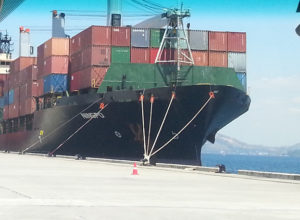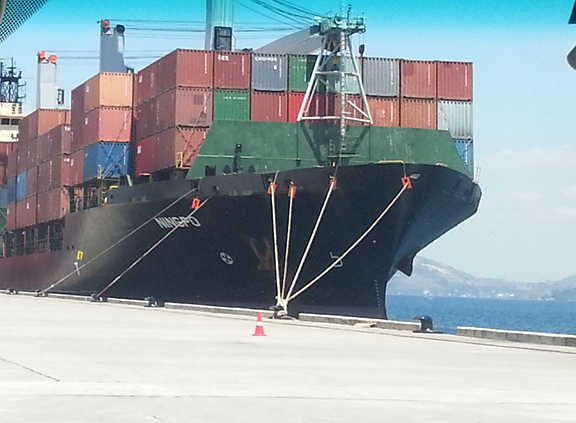 The Subic Bay Metropolitan Authority (SBMA) has issued its own rules implementing the Safety of Life at Sea Convention (SOLAS) on verified gross mass (VGM) at the Port of Subic.
The Subic Bay Metropolitan Authority (SBMA) has issued its own rules implementing the Safety of Life at Sea Convention (SOLAS) on verified gross mass (VGM) at the Port of Subic.
The rules, approved by the SBMA Board on July 14 and which took effect last August 1, are loosely based on those issued by the Philippine Ports Authority (PPA), released on June 16 and effective July 1. PPA oversees most of the ports in the country.
Under the SOLAS VGM, no container will be loaded onto a vessel if it does not have a VGM starting July 1.
READ: PH port authorities issue guidelines on verified gross mass
In memorandum circular 2016-06.10.001, SBMA said that with the SOLAS VGM rule taking effect last July 1, the shipper (or a designated third party) has the responsibility to weigh the packed container or its contents under either of two allowed methods, using equipment that meets national certification and calibration requirements.
In the first method, the shipper may weigh the packed and sealed container with calibrated and certified equipment. The second calls for weighing each item—including the mass of pallets, dunnage, and other packing and securing materials to be packed in the container—and adding the tare mass of the container to the total weight of its contents. The second method needs to be certified and approved by the National Metrology Laboratory of the Philippines (NLMP).
SBMA noted that “weight estimation of container’s contents is prohibited.”
To implement the SOLAS VGM requirement and ensure the efficient and smooth flow of commerce, the Freeport authority advises parties in the supply chain “to make arrangements for the timely transmission and exchange of VGM information.”
READ: INTTRA develops e-platform for relaying verified box weight
Carriers should give shippers cut-off times to provide them the required container weight verification so they can prepare a ship stowage plan. These cut-off times, SBMA noted, may vary depending on the carrier as well as the operational procedures or requirements of different terminal operators.
“Shippers should learn of such documentation cut-off times from the carrier with whom they are doing business,” SBMA noted.
Moreover, the weighing of a loaded container for export is to be verified by the port terminal operator through its calibrated and certified weighbridge that meets the accuracy standards and requirements of SOLAS VGM and has been approved, certified, and calibrated by the NLMP for non-automatic weighing instruments.
READ: BIC container tare weight database goes live
If the weighbridges of terminal operators Subic Bay International Terminal Corp. (SBITC) and ICTSI Subic, Inc. (ISI) are not operating or functioning, or for out-of-gauge cargoes packed in an open container (flatrack/open top), the weighbridges of Mega Subic Terminal Services, Inc. (MSTSI) at the NSD Compound and Subic Seaport Terminal, Inc.’s (SSTI) at the Boton Area can be utilized with the consent of the company or shipper. The shipper is duty bound to shoulder payment of the weighbridge charges of MSTSI or SSTI, SBMA noted.
If the shipper opts to utilize the SBMA-accredited weighbridge outside of the New Container Terminal (NCT), he must provide the information to the carrier prior to the container’s entry into the container terminal.
The carrier in turn has to transmit the shipper’s declared container weight to the terminal operator using the agreed format and standard (Container Pre-Advise System), so that the terminal operator will have the information once the packed container arrives, the circular said.
SBMA requires that a packed container should not exceed the maximum gross mass indicated on the Safety Approval Plate under the IMO’s Convention for Safe Containers, as amended.
A container with a gross mass that exceeds the maximum permitted weight will not be allowed aboard a ship and will also incur shut-out charges, SBMA noted.
On the part of the denied shipper, he has the option to withdraw the overloaded container from the terminal or go to a designated holding area where special services or measures may be provided to enable him to strip the container and comply with the prescribed maximum gross weight.
“Any discrepancy between a packed container’s gross mass declared prior to the verification of its gross mass and its verified gross mass should be resolved by using the verified gross mass result from the weighbridge of the container terminal,” it said.
Any overloaded container or loaded container without VGM that has been denied loading onto the vessel will sustain all various expenses that may incur, including shut-out charges, storage fees, and stripping, re-weighing, and other port charges.
Meanwhile, Efledo Resma, Port Management Department acting manager of the Phividec Industrial Authority, which oversees the Mindanao Container Terminal in Tagaloan, Misamis Oriental, told PortCalls they are using the PPA guidelines for implementing the VGM. – Roumina Pablo
READ: PPA tells shippers on VGM rule: Compliance shouldn’t be so hard





